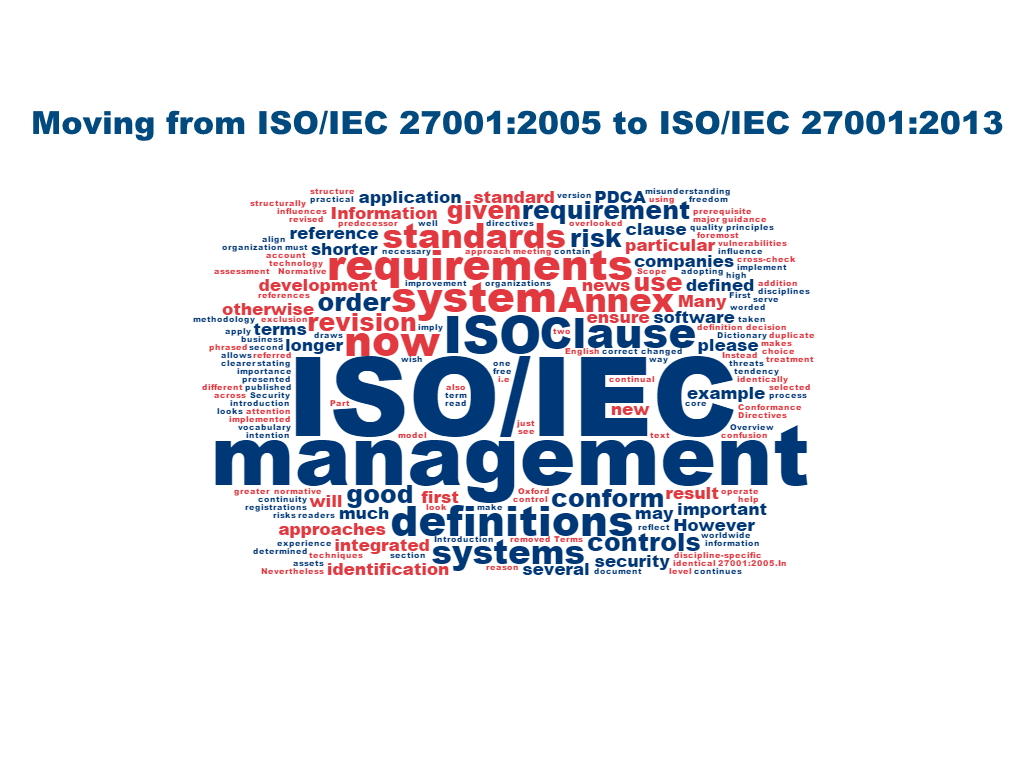ISO/IEC 27001:2013 is the first revision of ISO/IEC 27001. First and foremost, the revision has taken account of practical experience of using the standard: there are now over 17,000 registrations worldwide. However, there have been two other major influences on the revision. The first is an ISO requirement that all new and revised management system standards must conform to the high level structure and identical core text defined in Annex SL to Part 1 of the ISO/IEC Directives. Conformance to these requirements will have a tendency to make all management system standards look the same, with the intention that management system requirements that are not discipline-specific are identically worded in all management system standards. This is good news for software application development companies that operate integrated management systems, i.e. management systems that conform to several standards, such as ISO 9001 (quality), ISO 22301 (business continuity) as well as ISO/IEC 27001. The second influence was a decision to align ISO/IEC 27001 with the principles and guidance given in ISO 31000 (risk management). Again, this is good news for integrated management systems as now an organization may apply the same risk assessment methodology across several disciplines.
The result is that structurally ISO/IEC 27001:2013 looks very different to ISO/IEC 27001:2005.In addition, there are no duplicate requirements, and the requirements are phrased in a way, which allows greater freedom of choice on how to implement them. A good example of this is that the identification of assets, threats and vulnerabilities is no longer a prerequisite for the identification of information security risks. The standard now makes it clearer that controls are not to be selected from Annex A, but are determined through the process of risk treatment. Nevertheless, Annex A continues to serve as a cross-check to help ensure that no necessary controls have been overlooked.
Clause 0: Introduction
This is a much shorter clause than its predecessor. In particular the section on the PDCA model has been removed. The reason for this is that the requirement is for continual improvement (see Clause 10) and PDCA is just one approach to meeting that requirement. There are other approaches, and organizations are now free to use them if they wish. Many software application development companies are adopting such approaches.
The introduction also draws attention to the order in which requirements are presented, stating that the order does not reflect their importance or imply the order in which they are to be implemented.
Clause 1: Scope
This, too, is a much shorter clause. In particular there is no reference to the exclusion of controls in Annex A.
Clause 2: Normative references
The only normative reference is to ISO/IEC 27000, Information technology — Security techniques — Information security management systems — Overview and vocabulary.
Clause 3: Terms and definitions
There are no longer any terms or definitions in ISO/IEC 27001:2013. Instead, readers are referred to ISO/IEC 27000. However, please ensure that you use a version of ISO/IEC 27000 that was published after ISO/IEC 27001:2013 otherwise it will not contain the correct terms or definitions. This is an important document to read. Many definitions, for example ‘management system’ and ‘control’ have been changed and now conform to the definitions given in the new ISO directives and ISO 31000. If a term is not defined in ISO/IEC 27000, please use the definition given in the Oxford English Dictionary. This is important, otherwise confusion and misunderstanding may be the result.
Author Signature: Shreyans Agrawal (ifour.shreyans.agrawal@gmail.com)
Author Signature: Shreyans Agrawal (ifour.shreyans.agrawal@gmail.com)

No comments:
Post a Comment